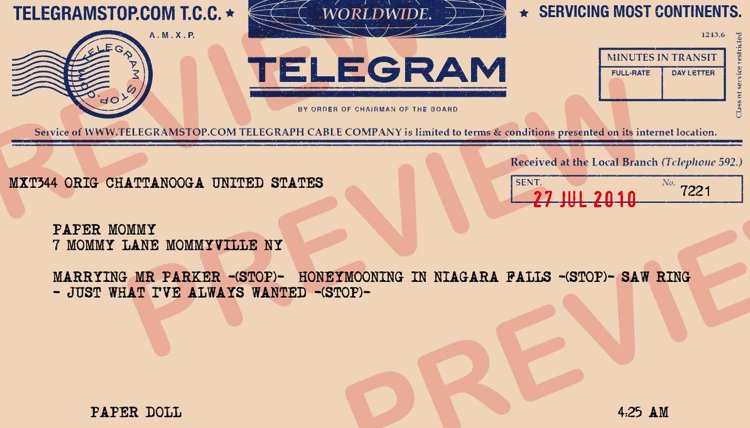From Desktop to Mailbox (Part 2): Send Telegrams From Your Computer
In a world of 420-character Facebook updates and 140-character tweets, it’s easy to feel that we modern-day writers invented brevity. The truth, however, is that we’re about 120 years behind the original micro-bloggers.
In a century before text messaging and email, in eras before faxes, and in epochs before telephone calls that didn’t require the shepherding and chaperoning of a long distance operator, there was a fast, semi-affordable way to get urgent messages across vast continents and oceans. Engagements were announced and wedding parties were congratulated, tragedies reported and inquiries made, all in a staccato priced-by-the-word, unpunctuated language of a hazy, far-off time.
Telegrams were as much part of cinematic lingo as calendar pages being torn away, and any viewer of World War II era movies knew what it meant when the telegram delivery boy’s bike approached a soldier’s family’s home. As family pictures turned from sepia to Kodachrome to digital, the world of the milk man, soda jerk and telegram delivery boy faded away.

Western Union, the heart of America’s telegraphy for about a century and a half, ceased of all of its telegram services in January 2006. It wasn’t a surprising business decision. In 1929, approximately 20 million telegrams were sent; in 2005, only 20,000. Western Union stayed afloat and still exists, but only as a financial services company. You can “cable” money through a Western Union wire transfer, but the glory days of messaging through Western Union are over.
Video may have killed the radio star, but the internet has not quite murdered the telegram.
![]()
Western Union sold its telegram service to iTelegram, an independent international communications company. Through iTelegram, you can send a Mailgram of up to 100 words for $18.95, which will take up to two-to-four business days to arrive–by mail. If you’re in a hurry and want your message to feel (and be delivered) like a real telegram, you can opt for a Priority Telegram for $24.95 plus 88 per word for same-day delivery in Manhattan, Los Angeles or Las Vegas, or next-business-day delivery in most other cities, and 12-hour delivery (including weekends) to hospitals, hotels and funeral homes. (Telegrams to Hawaii, Alaska, and rural areas take even longer.) Priority telegrams look similar to later-era (read: style-lite) Western Union telegrams.
iTelegram also provides a PhoneGram service, whereby you can call an operator, dictate your message and have it called directly to your recipient…for $9.95 for 30 words. Paper Doll wonders what could possibly be the appeal of having your voice message delivered by a stranger (Wait, Wait, Don’t Tell Me‘s Carl Kassel notwithstanding).

American Telegram does offer hand-delivered telegrams–for a whopping $28.95 plus 89 per word for next-day delivery or $44.95 plus 89 per word for same-day delivery — but note that the words in the recipients’ addresses count towards the word total! If neither time nor charm is important, 2- and 3-day ZipGrams are available ($19.95 plus 59/word or $15.95 plus 59 per word, respectively, with options to send FlowerGrams and CandyGrams.
The above options seem like a waste of money as well as paper. Somehow, Paper Doll senses the dapper spirit of Cary Grant growing melancholy at the thought of trying to send one of the above to the heroine as her ship steams across the ocean.
The romance of the telegram your great-grandmother received from her beau, as the train sped him ever closer to her side? It’s not so easy to recreate that frisson of delight using the above services, and their charmless solutions would seem to create more clutter than (sentimental) flutter. Mr. and Mrs. America and all the ships at sea just aren’t collectively hungering for the return of that kind of telegram. However, you can try to put a telegraph office on your desktop with the help of the following solutions.

Telegram Stop has developed a simple yet delightful site to send a traditional-style telegram via the internet.
1) Choose to send one basic message or opt for multiple recipients.
2) Craft your message. If you’re having trouble getting into the old-timey style, the site has suggestions to smooth any writer’s block and provides some insight into the tricks of growing your telegram mojo:

3) Fill in the pertinent details for the recipient and sender, and select the category of telegram (e.g., proposal, birth, anniversary, etc.).
4) Decide whether you want to the telegram sent immediately, or schedule a future arrival date.
5) You can also opt to send by registered mail and/or upload a photo to be printed and included with the telegram (perfect for baby announcements to great-grandparents who lack email…or just prefer old-time charm).
6) Preview your TelegramStop telegram*:

Either edit it, or pay the flat fee of $5.65 (by credit card or PayPal), no matter to what country you are sending.
These telegrams aren’t, of course, sent by telegraph, nor are they delivered by a gangly teenager on his bike. (Hey, at least you won’t have to tip him.) They are, however, sent by mail in old-fashioned envelopes with old-style fonts, evoking the days when women wore pearls to vacuum and Burma Shave signs passed for in-vehicle entertainment. Delivery can take 4-8 days, so again, the appeal is the retro nature and not speed. Given all the other competition, TelegramStop messages are also pretty reasonably priced.

Retro-Gram provides a similar blast-from-the-past communications experience, though perhaps as a paler imitation of already sun-bleached old-style telegrams. That’s because Retro-Gram sends snappily-designed Old-School telegrams, but delivers them via email. Of course, they’re free, which is always an advantage if you’ve spent all your money at the nickelodeon or malt shop.
1) Click on the picture of the askew telegram to get started. (There’s no obvious link — you have to intuit your starting point.)
2) Choose from among six telegram styles — the basic Retro-Gram (1930s classic style–purple type on a yellow background), an Electrogram (circa the 1920s), Electric Mailgram (a more formal 1930s version), Aethergram (19th century stylings), Worldwide Webgram (WWII-era) or Retro-Gram Nouveau (for a 1950s feel).
3) Retro-Gram feeds your information into a custom database and formats it in one of two basic vintage telegram styles, either ALL CAPS, like most U.S. telegrams, or in all lowercase to match the transcontinental Aethergram and Internationale designs popular before before WWI.
They generate a PDF combining your message with their Retro-Gram artwork and email the PDF to your recipient, whom, they assure you, will be “deeply impressed with your style and class.” Indeed.
If you like the style, but are craving something a little more tangible, Retro-Gram’s Deluxe service includes printing telegrams at high-resolution on “historically appropriate” aged paper and framing them…for $49.95.
(The site also offers a charming history of telegraphy and recommends Tom Standage’s The Victorian Internet.)

The UK’s Gratia Telegram Service provides a more continental feel with old world detailing.
1) Create an account to register and then log-in. (Gratia doesn’t seem entirely comfortable with newfangled browsers. Have patience.)
2) Click on “Send a Telegram” to select your design options from blue, black or burgundy detailing and backgrounds including vintage-era graphics and/or photos, ranging from 8.99-9.99.
3) Proof-read the PDF version of the telegram you’ve created:

and either revise or pay.
With a wink to the modern era, you can also turn a tweet into a telegram with a Gratia Twittergram for 3.99, with just a few extra clicks.
And, you may choose a nostalgic-style or picture telegram to download as a PDF (ostensibly to send as an email or post on your own site) at no cost.
![]()
EZGram.com offers a services that’s a hybrid of the mail-from-your-desktop paper-free letters we discussed last week and the sense of urgency of a telegram.
1) Fill in the form with your return address, date, delivery address, greeting (e.g., Dear Senator Jefferson Smith–you heard about Mr. Smith going to Washington, right?), text of your message, and polite closing, just as you were taught in fourth grade.
EZGram knows not everyone is a natural writer, so the site includes templates for writing everything from letters of acceptance of employment to notifications of canceled weddings.
2) If you haven’t already done so, you’ll be prompted to sign up for an account in which to save your missives.
3) Preview your letter and either edit or continue.
4) Pay for your mail ($1 per letter, printed, stuffed, stamped and sent) by credit card or PayPal, or load your account with discounted EZDollars: $20 for 24 letters, $80 for 100 letters or $150 for 195 letters.
EZGram will send your message in a traditional-style AirGram envelope.

For addition fees, EZGram allows extra pages or color printing, will let you upload a PDF, enables international mailing and facilitates USPS Priority Mail.
Yes, this has all the (lack of) charm of the mail-from-your-desktop options we discussed last week. However, EZGram’s service isn’t focused necessarily on sending a letter to your Great Aunt Tilly. EZGram specializes in supporting the promotion of causes and makes it easy to contact your representation in Congress. Once you set up your account with your address, EZGram supplies the checkboxes to contact whichever senators and representatives you wish, from one central screen. You’ll save time and effort, and they’ll get AirGrams that make clear your stand on the issues.
While the days of snazzily lo-fi and affordable telegrams are sadly over, the stories live on. Two of my favorites:
The first is often-quoted, though many are unaware it was drafted as telegram. In 1897, when an American newspaper mistakenly published Mark Twain’s obituary, he dashed off a telegram from London, saying, “The reports of my death are greatly exaggerated”. Perhaps the same may be said of telegrams.
Irish writer Oscar Wilde is widely known for his impressive and pithy turns of phrase. Let’s face it, the guy invented snark. But he’s also known for having joined in the shortest telegram conversation ever known. While living in Paris, Wilde sent a telegram to his publisher in Britain to gauge the success of his new book. Without even the need for one -STOP-, he inquired: “?”
With exuberance at the sales, his publisher cabled back: “!”
*Mr. Parker was Paper Doll‘s imaginary husband, circa 1971 -STOP- He disappeared into the mist in the crowded hallways of Maple West Elementary School. -STOP- If you have any knowledge of Mr. Parker’s current whereabouts, please reply by return cable ASAP. -STOP-




Follow Me